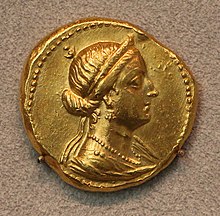Arsinoe III of Egypt
| Arsinoe III Thea Philopator | |||||
|---|---|---|---|---|---|
 Obverse of coin depicting Arsinoe III | |||||
| Queen of the Ptolemaic Kingdom | |||||
| Reign | 220–204 BC[1] | ||||
| Co-regent | Ptolemy IV | ||||
| Born | c. 246–245 BC | ||||
| Died | 204 BC | ||||
| Spouse | Ptolemy IV | ||||
| Issue | Ptolemy V Epiphanes | ||||
| |||||
| Dynasty | Ptolemaic | ||||
| Father | Ptolemy III | ||||
| Mother | Berenice II | ||||
Arsinoe III Philopator (Ancient Greek: Ἀρσινόη ἡ Φιλοπάτωρ, Arsinóē hē Philopátо̄r, meaning "Arsinoe the father-loving", 246 or 245 BC – 204 BC) was Queen of Ptolemaic Egypt in 220 – 204 BC. She was a daughter of Ptolemy III and Berenice II and spouse of her brother Ptolemy IV.[2] She was the first Ptolemaic queen to bear her brother's child.[3]
Life
[edit]Between late October and early November 220 BC, she was married to her younger brother, Ptolemy IV. She took an active part in the government of the country, at least in the measure that it was tolerated by the all-powerful minister Sosibius.
In 217 BC, she accompanied Ptolemy IV along with 55,000 troops at the Battle of Raphia in Palestine against Antiochus the Great with 68,000 troops.[4] Arsinoe may have commanded a section of the infantry phalanx.[4] Both sides employed cavalry, elephants, and specialized troops such as archers, as well as traditional Macedonian phalanx.[4] When the battle went poorly, she appeared before the troops and exhorted them to fight to defend their families. She also promised two minas of gold to each of them if they won the battle, which they did.[5]
In summer, 204 BC, Ptolemy IV died. His two leading favorites, Agathocles and Sosibius, fearing that Arsinoe would secure the regency, had her murdered by Philammon in a palace coup[6] before she heard of her husband's death, thereby securing the regency for themselves.
Issue
[edit]Legacy
[edit]Eratosthenes wrote a manuscript called the Arsinoe, which is lost, the subject being a memoir of the queen. It is quoted by many ancient scholars.[7]
Portraits of her likeness are also rare, but do exist in the forms of a bust of marble,[8] and another of bronze.[9]
References
[edit]- ^ Chrystal, Paul (2017-02-28). Women at War in the Classical World. Grub Street Publishers. ISBN 978-1-4738-5661-5.
Arsinoe III was Queen of Egypt from 220–204 BCE,
- ^ Dodson, Aidan, and Hilton, Dyan. The Complete Royal Families of Ancient Egypt. Thames & Hudson. 2004. ISBN 0-500-05128-3.
- ^ Tyldesley, Joyce (2006). Chronicle of the Queens of Egypt: From Early Dynastic Times to the Death of Cleopatra. London, UK: Thames & Huson Ltd. pp. 194. ISBN 0500051453.
- ^ a b c Pennington, Reina (2003). Amazons to Fighter Pilots: A Biographical Dictionary of Military Women. Westport, CT: Greenwood Press. p. 25. ISBN 0313327076.
- ^ Meyers, Carol; Craven, Tony; Kraemer, Ross S., eds. (2000). Women in Scripture: A Dictionary of Named and Unnamed Women in the Hebrew Bible, the Apocryphal/Deuterocanonical Books, and the New Testament. New York: Houghton Mifflin. p. 397. ISBN 0-395-70936-9.
- ^ Bennett, Chris (14 Sep 2006). "Arsinoe III". Ptolemaic Dynasty. Tyndalehouse. Retrieved 18 Apr 2021.
- ^ Carney, Elizabeth Donnelly; Müller, Sabine, eds. (2020). The Routledge companion to women and monarchy in the ancient Mediterranean world. Routledge. pp. 113–114. ISBN 978-0-429-43410-5. OCLC 1154099146.
- ^ "Marble Bust of Arsinoe III". egymonuments.gov.eg. Retrieved 2021-06-03.
- ^ M.Daehner, Jens; KennethLapatin; AmbraSpinelli (2017-11-17). "Artistry in Bronze: The Greeks and Their Legacy (XIXth International Congress on Ancient Bronzes)". Artistry in Bronze. Retrieved 2021-06-03.
